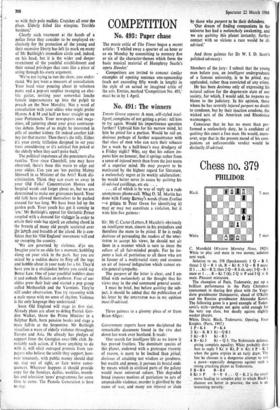Chess no. 379
PEILIDOR
Black White 7 men
C. Mansfield (Western Morning News, 1921). White to play and mate in two moves; solution next week.
Solution to no. 378 (Speckmann): 1 Q - R 8, threat 2 Q-R 1 ch,R-Kt 8; 3 Q-R 8 mate. If 1 ... Kt - R 2; then 2 Q - R 8 ch, any; 3 Q - R mateorl...R-Kt 7 (8); 2 Q xPand 3Q xR mate. Pleasant miniature.
The champion of Paris, Todorcevic, put up a brilliant performance in the Paris Christmas tournament in sharing first place with the Yugo- slave grandmaster Damjanovic, ahead of O'Kelly and the Russian grandmaster Alexander Kotov. The following game is a good example of Todor- cevic's style—perhaps not quite solid enough for the very top class, but deadly against slightly weaker players.
White, Ducic. Black, Todorcevic. Opening, Four Knights. (Paris, 1967.) 1 P - K 4 P - K 4
2 Kt - K B 3 Kt - Q B 3 3 Kt - B 3 Kt - B 3
4 B - Kt 5 Kt - Q 5. The Rubinstein defence, giving complete equality; White probably does best to reply 5 Kt x Kt, P x Kt; 6 P - K 5 when the game expires in an early draw. The line he chooses is a dangerous attempt to %sin a pawn—especially dangerous against such a strong attacking player as Todorcevic.
5 B - B 4 B - B 4 6 Kt x P 0 - 0 6 . . . Q - K 2 is the usua!
move leading to complex play in which Black', chances are better in practice; the text is an interesting novelty..
7 P-Q3 P-Q4 8 Kt x P P - Q Kt 4. The idea—more ex- perience of the variation is needed to say whether Black's 6th-8th moves get question or exclamation marks.
9 Kt X KBP... Probably best. 9 P - B 3, P X B; 10 P X Kt, Kt x Kt; 11 P X B, Kt - Kt 5 is a line worth further examination. R x Kt 10 Kt X Kt ch Q X Kt 11 B x R ch Q x R 12 B-K 3 Q-Kt3
13 Q - Q 2 .. . 13K - B 1 is,! think, better,
followed by P - Q B 3 and Black retains his three pawns and may have the advantage.
13 . . . P - Q R 4. Here 13 ... Q X Kt P; 14 0 - 0 - 0, Kt B 6 looks better; for White now has a second chance of K - B 1.
14 P-QB3 Qx KtP 150-0-0 Kt- B 6 16 Q-K 2 B-K 2 17 B - B 4? . . 17 P - Q 4 is surely better, partially freeing his position and getting his pawns moving.
17 . . . B - K Kt 5 18 Q - K 3 P - Kt 5. Threat 19 P x P, P x P; 20 R - Kt 1, K - B 2; 21 B - Q 2 with a winning attack.
19 K-B 2 P-B4 20 R-QB1 B-K 3 21 P - Q R 3? . .21 K - Kt 1 is better though White's position is now very difficult anyway.
21 . . . B - R 7! Threat 22 ... P - Kt 6 ch; 23 K-QI,Qx Rch.
22 RPXP RPxP 23 P - Q 4 B - B 5! Closing the outlet on Q 3 for the WK and threatening 24 . . . P - Kt 6; 25 K - Kt 1, Kt - Q 7 ch!; 26 Q x Kt, Q x P ch winning.
24 P - Kt 3 R - R 7 ch. Naturally.
25 K - Kt I B x P . . . Threat 26 . . .
Kt - Q 7 ch; 27 Q x Kt, Q x P chl 26 KR-Q1 R xP 27 Resigns . . . He must give up his queen
with 27 Q x R to avert the threat of 27 . • . R - Kt 7 ch; 28 K - R I, R - R 7 ch; 29 K - Kt 1, Q - Kt 7 mate.







































 Previous page
Previous page